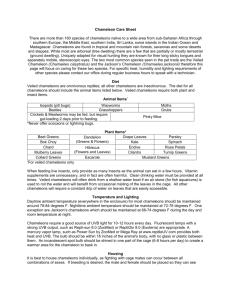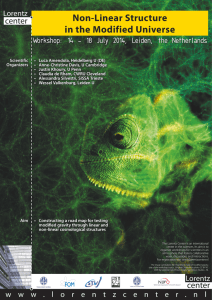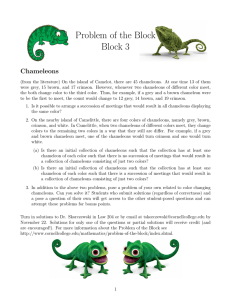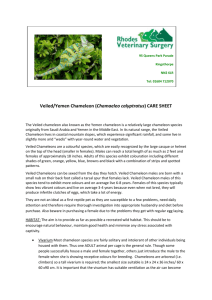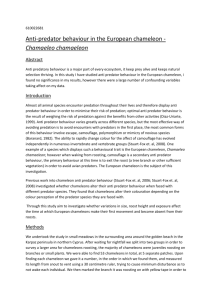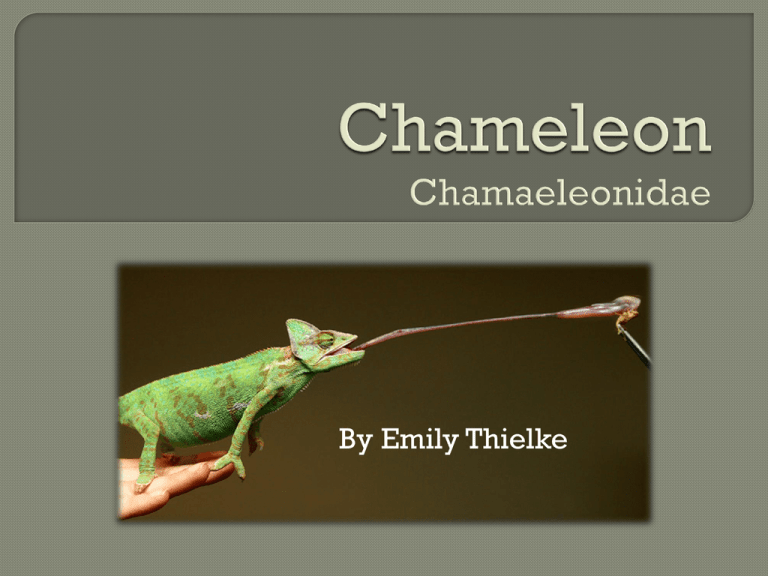
By Emily Thielke
There are many different types of chameleons.
By current classification there are more than 160
different species of chameleons in the world these are
just a few:
Veiled Chameleon (Chamaeleo calyptratus)
Flap-necked Chameleon/Graceful Chameleon (Chamaeleo dilepis)
Four-horned Chameleon (Chamaeleo quadricornis)
Cameroon Sail-finned Chameleon (Chamaeleo montium)
Panther Chameleon (Furcifer pardalis)
Jacksons Chameleon (Chamaeleo jacksoni xantholo-phus)
Leaf Chameleon (Brookesia superciliaris)
The
most common Chameleon available for
purchase seems to be the Veiled Chameleon
Fun Fact:
Veiled Chameleon’s are also known as the Yemen
chameleon
Life Span:
• approximately 5 years in captivity.
Size:
• Males can reach 18-24 inches in total, while females tend to be quite a
bit smaller at 10-13 inches.
Temperament:
• Territorial and aggressive to other chameleons, and should be housed
individually, docile towards people, however, handling tends to be
stressful.
Appearance:
The veiled chameleon has a large, tall helmet-like structure on the top of their
head that is present in both males and females, though larger in males. Their
bodies are banded in shades of green, yellow and brown.
Veiled Chameleons are some of the easiest sex
Males have a calcar or heel spur that females do not have. This
spur exists even in hatchling veiled chameleons, and is a reliable
indicator of sex in this species
Male veil’s have a much
higher casque than female
Often display different color
patterns too.
Males
• bright, canary yellow stripes
• with green stripes running
vertically across their bodies
• dots of various colors within
the stripes
the most commonly colored dot is
blue
Females
are
generally an overall
soft green color,
without large yellow
stripes
Veiled chameleons, when startled or threatened may darken in
color and "play possum”
Color changes can also be rapid, as when reacting to a threat, or
gradual.
Chameleons change color for many different reasons:
•
•
•
•
•
•
•
•
•
•
Health status
Perception of a threat or incursion into its territory
Presence of a mate
Status of its shedding
Age
Sex
Season
Temperature
Light
Other environmental factors
Chameleon’s reach sexual maturity within four to five
months, at 8 to 12 inches long
Male veiled chameleons will display to females by
laterally compressing their bodies, rocking back and
forth, curling and uncurling their tails, and displaying
extremely bright color
The females indicate sexual readiness by displaying
robin-egg blue dots on their body
•
may be all over the body, or only in a small area
Observing the females behavior when introduced to a male is also
important in regards to breeding…
If the female is ready and receptive:
• she will "ignore" the male after she
catches sight of him and will begin to
crawl away slowly, retaining her
coloration
If she is not receptive:
• she will let both you and the male
know by hissing loudly, gaping,
rocking back and forth on a branch,
and drastically changing her color to
black with yellow and green stripes or
spots
Other color variations have been noticed
Note the blue-ish dots all over her body
Egg laying occurs between 20 and 30
days after mating, with clutch sizes
ranging from 35 to 85 eggs!!
(some have even been reported to have up to 100)
Eggs appear white and oval with
tough-skin and are buried in
warm sand
Gravid veiled
chameleons will take on a
"baseball"-like
appearance in their
abdomen as the date of
oviposition draws closer.
Some even look like they
could explode!
On day 15, move the female into an egg laying chamber
Females will refuse food before egg laying, but you can
feed a willing female by placing an opaque feeding dish
in with her
• It is important that the insects cannot escape from the dish
Once the eggs have been laid,
she will pack the sand down on
top, leaving no trace of her
activities
Example of size
After
laying her eggs the female should be
removed from the chamber and placed in
another where she will not encounter stress
Make
sure she drinks plenty of water as she
will be exhausted and dehydrated after egg
laying
After
taking care of the female, dig up her eggs
and incubate them
Be extremely careful not to rotate or change the position of the
eggs when removing them to the incubation container
This is essential because each egg contains an air pocket. Each
embryo is oriented in the egg and if the air pocket moves, the
embryo may suffocate
Veiled Chameleon eggs should
be incubated at 75° to 80°F
[24° to 27°C]
(differs from species to species)
It is very easy to incubate
the eggs with too much humidity
(usually above 85%)
Veiled chameleon eggs can take
from 4 to 9 months to hatch
For first four months check the
eggs once a week
•
Humidity, temperature, rotting eggs
The first days up to two
weeks are the most critical
Not all chameleons will
hatch at the same time.
Typically, Veiled
chameleons in a single
batch of eggs will hatch
within a week of each
other, often within two
days
The size and weight of
the branches is
important for baby
chameleons
Misting with water 3
times a day is also
essential
Feed wet cricket
food/gut load to help
with hydration
Feed
:
• pin head or fly sized crickets, small wax worms
and termite larva
DO NOT let food exceed the width of its head
Dry and wet gut insects can also be fed to help with
hydration as well as remember to mist with water
Dust insects with calcium powder twice weekly
Feed:
Crickets, king mealworms, grasshoppers, roaches, wax worms and
silk worms
Blossoms and leaves from dandelions, hibiscus, ficus, romaine and
escarole
Dust insects with calcium powder twice weekly for ovulating
females
Several babies can be housed
temporarily in a 15 gallon
terrarium
Minimum cage size should be
2 x 2 x 3 feet for and adult pair
Semi-arid (Having low precipitation
but able to support grassland and
scrubby vegetation. Steppes have
semiarid climates) setup is ideal
A wired cage is best for air
exchange
Potted plants such as ficus
provide visual barriers and
add humidity
Mist leaves and branches
once or twice daily
• Not only does this aid the plants
in the terrarium but it is how the
Chameleon will get its water, by
drinking from the droplets on the
leaves
Using
paper towels or newspaper
to line the cage makes cleaning
easiest
Potted plants can be placed on a
plain paper substrate for easier
cleaning as well
DO NOT use wood chips or any
other substrate that could be
accidentally ingested and cause
blockages.
Lots of sturdy non-toxic plants and branches
Ficus trees are often used in chameleon housing, but require
some caution as the sap can be irritating
Other plants include pothos, hibiscus, and dracaena.
Artificial plants and vines may also be added
A good selection of branches (of different diameters) should be
provided
Make sure the branches and perches are sturdy and secure
Chameleons
need an ultraviolet
(UVA/UVB) light source
Keep the UV light on for 10-12 hours per
day
Replace every 6 months
Also
benefit from spending time
outdoors in natural sunlight just make
sure shade is available and the weather is
warm enough
Veiled
chameleons need a moderate
humidity level (50%)
Misting the plants twice daily will help
with humidity levels, and a drip or
misting system is also recommended
Metabolic Bone Disease:
• This is one of the most important diseases to pay attention to
• It occurs when your Chameleon is not receiving enough calcium
and Vitamin D for their bones to grow properly.
Treatment:
• Provide full-spectrum lighting, gut loading the feeder insects
with healthy foods, and dusting the insects with a calcium/multivitamin powder.
Vitamin A Deficiency:
• This results in eye problems, respiratory problems,
neurological dysfunction and difficulty shedding.
Treatment:
• Give a solution orally (usually by the veterinarian)
• dusting with multi-vitamin powder (2 times a week),
• gut load insects green leafy vegetables, carrots and sweet
potato.
Female
Chameleons commonly get egg bound
as well
Can be caused by:
• Lack of suitable site to lay her eggs
• Stress
• Poor nutrition
• Hormonal problems
Medical management can include
• Increasing humidity and temperature
• Administering calcium gluconate injections
• Fluid therapy
• Providing a suitable substrate for egg laying
The other option is surgical removal of the eggs
Most radiographs can be taken without chemical
restraint
Normal Views are dorsal/ventral and lateral
Ticks and Mites are common ectoparasites
Nematodes, cestodes, coccidian, flagellates and amoebae are all
intestinal parasites of chameleons
Clinical signs of parasitism may include:
•
•
•
•
•
general un-thriftiness
weight loss or poor weight gain
anorexia
Regurgitation
vomiting and abnormal stools
May be found in multiple areas of the body and subcutaneously
Appear as raised areas under the skin are often mistaken for
abscesses.
They MUST be surgically removed by a veterinarian.
IM injections should be given in the front limbs (if
needed to be given)
• If administered in the hind legs the renal portal system
delivers the agent to the kidneys and is quickly filtered
out
The most common technique used for collecting
blood samples from chameleons is ventral tail
venipuncture and jugular venipuncture
• Should use a tuberculin syringe with 22-25 gauge needle
Total blood volume taken should be about 5-8%
of the total body weight and should be collected
in a green top tube
Administering
difficult
oral meds in reptiles is
• Restrain head (restraint is key)
• Gently pry open the mouth
Chameleons
lateral scales
receive SQ fluids between
No fasting is required
Because they are ectotherms they can be slower to
induce, difficult to maintain and slower to recover
Injectable drugs go IV or IO to reduce the risk of
hitting organs
Inhalants are usually isoflurane and sevoflurane
Their tongues can be anywhere from 1 to 11/2 times
the body length of the Chameleon and can rocket in
and out with blinding speed
A 51/2" tongue reaches full extension in 1/16th of a
second, which is fast enough to snatch a fly in
midair.
Chameleon's eyes are the most distinctive
among the reptiles.
It has scaly lids shaped like a cone, with only a
small, round opening in the middle for the
pupil
The chameleon can rotate and focus its eyes
separately to look at two different objects at
the same time!
When the chameleon sees prey, both eyes can
focus in the same direction to get a clearer
Retrieved on 2/25 – 3/6
http://www.reptileknowledge.com/squamata/chamaeleonidae.
php
http://nationalzoo.si.edu/Animals/ReptilesAmphibians/Facts/Fa
ctSheets/Veiledchameleon.cfm
http://exoticpets.about.com/od/chameleons/p/veiledcham.ht
m
http://raisingkittytheveiledchameleon.blogspot.com/
http://webspinners.com/coloherp/careshts/lizards/veilcham.p
hp
http://www.angelfire.com/fl/chameleons/veiled/veiled.html
http://www.chameleoncrazy.com/incubation.php
http://www.the-lizard-lounge.com/content/species/veiledchameleon.asp
Retrieved on 2/25-3/6
Exotic Animal Care and
Management
• Vicki Judah and Kathy Nuttall
• Copyright 2008 Thomson Delmar
Learning
Reptiles, Amphibians and
Invertebrates
• An Identification and Care
Guide
Patricia P. Bartlett, Billy Griswold
DVM and R.D. Bartlett
Copyright 2001 Barrons
Educational Series
www.barronseduc.com


